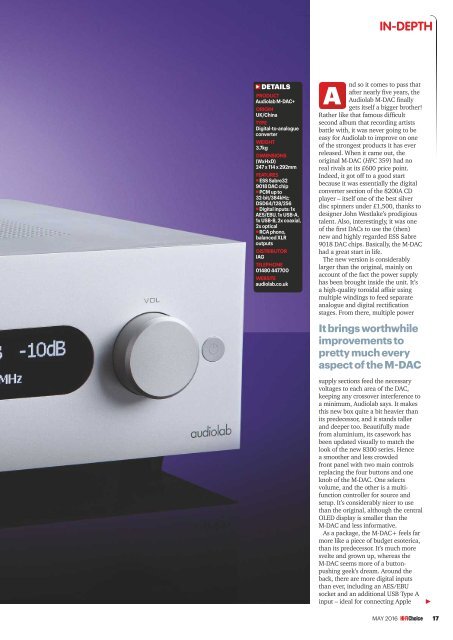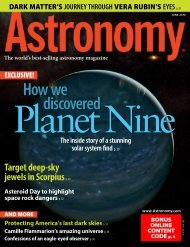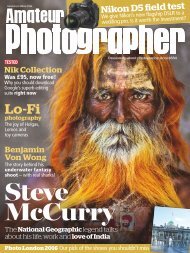You also want an ePaper? Increase the reach of your titles
YUMPU automatically turns print PDFs into web optimized ePapers that Google loves.
IN-DEPTH<br />
DETAILS<br />
PRODUCT<br />
Audiolab M-DAC+<br />
ORIGIN<br />
UK/China<br />
TYPE<br />
Digital-to-analogue<br />
converter<br />
WEIGHT<br />
3.7kg<br />
DIMENSIONS<br />
(WxHxD)<br />
247 x 114 x 292mm<br />
FEATURES<br />
● ESS Sabre32<br />
9018 DAC chip<br />
● PCM up to<br />
32-bit/384kHz;<br />
DSD64/128/256<br />
● Digital inputs: 1x<br />
AES/EBU, 1x USB-A,<br />
1x USB-B, 2x coaxial,<br />
2x optical<br />
● RCA phono,<br />
balanced XLR<br />
outputs<br />
DISTRIBUTOR<br />
IAG<br />
TELEPHONE<br />
01480 447700<br />
WEBSITE<br />
audiolab.co.uk<br />
A<br />
nd so it comes to pass that<br />
after nearly five years, the<br />
Audiolab M-DAC finally<br />
gets itself a bigger brother!<br />
Rather like that famous difficult<br />
second album that recording artists<br />
battle with, it was never going to be<br />
easy for Audiolab to improve on one<br />
of the strongest products it has ever<br />
released. When it came out, the<br />
original M-DAC (HFC 359) had no<br />
real rivals at its £600 price point.<br />
Indeed, it got off to a good start<br />
because it was essentially the digital<br />
converter section of the 8200A CD<br />
player – itself one of the best silver<br />
disc spinners under £1,500, thanks to<br />
designer John Westlake’s prodigious<br />
talent. Also, interestingly, it was one<br />
of the first DACs to use the (then)<br />
new and highly regarded ESS Sabre<br />
9018 DAC chips. Basically, the M-DAC<br />
had a great start in life.<br />
The new version is considerably<br />
larger than the original, mainly on<br />
account of the fact the power supply<br />
has been brought inside the unit. It’s<br />
a high-quality toroidal affair using<br />
multiple windings to feed separate<br />
analogue and digital rectification<br />
stages. From there, multiple power<br />
It brings worthwhile<br />
improvements to<br />
pretty much every<br />
aspect of the M-DAC<br />
supply sections feed the necessary<br />
voltages to each area of the DAC,<br />
keeping any crossover interference to<br />
a minimum, Audiolab says. It makes<br />
this new box quite a bit heavier than<br />
its predecessor, and it stands taller<br />
and deeper too. Beautifully made<br />
from aluminium, its casework has<br />
been updated visually to match the<br />
look of the new 8300 series. Hence<br />
a smoother and less crowded<br />
front panel with two main controls<br />
replacing the four buttons and one<br />
knob of the M-DAC. One selects<br />
volume, and the other is a multifunction<br />
controller for source and<br />
setup. It’s considerably nicer to use<br />
than the original, although the central<br />
OLED display is smaller than the<br />
M-DAC and less informative.<br />
As a package, the M-DAC+ feels far<br />
more like a piece of budget esoterica,<br />
than its predecessor. It’s much more<br />
svelte and grown up, whereas the<br />
M-DAC seems more of a buttonpushing<br />
geek’s dream. Around the<br />
back, there are more digital inputs<br />
than ever, including an AES/EBU<br />
socket and an additional USB Type A<br />
input – ideal for connecting Apple<br />
MAY 2016 17






